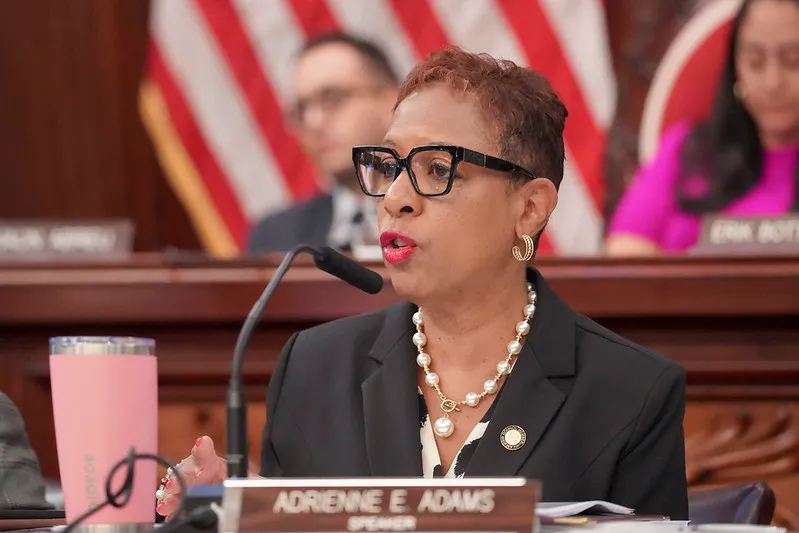Altered 'City of Yes' Housing Plan Passes Two Key City Council Committees
The final deal struck between the mayor’s office and the council to get the plan over the finish line includes a $5 billion commitment from the administration to fund the council’s housing priorities.

Photo by Susan De Vries
By Ethan Stark-Miller, amNY
A slightly weaker version of Mayor Eric Adams’ controversial City of Yes zoning reform package, aimed at making it easier to build more housing in the Big Apple, cleared two key City Council committees on Thursday.
The final deal struck between the mayor’s office and the council to get the plan over the finish line includes a $5 billion commitment from the administration to fund the council’s housing priorities.
The mayor’s “City of Yes for Housing Opportunity,” a bundle of proposals designed to make it easier to build a “little more housing in every neighborhood,” seven-member Zoning Subcommittee and the 11-member Land Use Committee. It passed the former panel by a 4-3 vote, and the latter panel by an 8-2 decision, with one abstention.
Mayor Eric Adams, speaking to reporters following the vote, said the committees’ passage of the plan was a “historic moment.” City of Yes will update zoning rules governing where and how much housing can be built in certain parts of the city that have not been touched since the 1960s.

“Nothing has been done like this in over half a century,” Adams told reporters. “This is an amazing benchmark that we are putting down in our commitment to deal with housing in our city.”
The vote took place over five hours after it was originally scheduled for due to ongoing 11th-hour negotiations.
During the first committee vote, Staten Island Council Member David Carr (R) made a motion to try to derail the vote, with support from fellow Staten Islander Kamillah Hanks (D), but it was swiftly voted down. Carr characterized the process by which the plan was crafted as a one-size-fits-all approach that was rushed through by the administration and did not account for areas that did not have the infrastructure to handle more development.
“This process, which the administration claims is going to result in a little housing everywhere and yet somehow will not tax our already over-taxed infrastructure, simply does not make sense,” Carr said.
Now, the zoning overhaul must clear one final hurdle — a December 5 vote by the full City Council.
The plan was originally designed to produce 100,000 units over 15 years, but with the changes, that number has been lowered to 80,000.
The scheme is the Adams administration’s signature policy aimed at building more homes across the five boroughs as the city continues to struggle with a massive housing shortage. The lack of enough home production is thought to be one reason why rents have skyrocketed in recent years, and only 1.4% of rental units sat vacant last year.
Allaying concerns
The amendments to the plan are intended to quell some council members’ fears — particularly those of lawmakers representing low-slung sections of the city — that the original version would change the character of their neighborhoods. Many of the city’s Community Boards also raised objections to the zoning overhaul or suggested changes to it.
“The question here is: how do we preserve the rich diversity in the city’s neighborhoods while still making sure that every community board contributes, not just more market housing, but also affordable housing,” said Bronx City Council Member Kevin Riley, chair of the Subcommittee on Zoning and Franchises.
As part of the agreement, City Council Speaker Adrienne Adams secured $5 billion from the administration to pay for the council’s housing priorities, which include funding for affordable housing construction, housing afforability and homeownership programs, infrastructure upgrades and increased staffing in relevant city agencies.
“The committees’ approval of the Council’s comprehensive housing plan to modify the Zoning for Housing Opportunity text amendment with major investments in City for All demonstrates that it is possible to create a significant amount of new housing in every neighborhood while respecting neighborhood character and investing in more affordable housing, communities, and homeownership,” Speaker Adams said in a statement.

Several notable alterations to the scheme were also made, intended to win the votes of council members who believed it would fundamentally change their communities by adding more housing and those who thought it did not do enough to boost affordable development.
One of the changes was made to a proposal allowing developers to build at least 20% more housing as long as it is affordable, a policy known as “Universal Affordability Preference” (UAP). Under the change, builders constructing projects of 10,000 square feet or more with UAP would need to make that additional affordable housing available at 40% of the Area Median Income (AMI).
Changing parking mandates
Another alteration was made to a proposal to eliminate the mandate that new developments be constructed with a certain number of off-street parking spots — a measure opposed by council members representing more car-dependent corners of the city.
The revamped version of the plan would instead institute a system with three distinct zones. Under that model, sections of the city that have ample access to public transit and low commute times would be completely exempted from the mandates, those with transit access but greater car dependence would have a 50% requirement and those where most residents drive would remain as they are now.
Manhattan south of 96th Street already has no parking mandates. The additional areas where they would be eliminated are in parts of Brooklyn, Queens and the Bronx that are closer to Manhattan.
Sarah Lind, co-executive director of the advocacy group Open Plans, said that while the City Council did not fully abolish the parking requirements, as the group pushed for, the plan is still a major step forward.

“This version of City of Yes is certainly a historic shift for New York’s zoning code; the Land Use Committee has designated the largest parking mandate-free district in the country and significantly lowered the number of required parking spots in areas where mandates still exist, which will help create much more urgently needed housing,” Lind said in a statement. “That said, this was a once-in-a-generation chance and we believe far too many New Yorkers still live in car dependence and transit deserts that are caused in part by parking mandates.”
Additionally, the reworked zoning package would restrict the construction of accessory dwelling units, small units built in or on the land of already existing homes, based upon certain conditions. ADUs can be located in basements, attics and backyards.
For instance, ADUs on ground level and in basements would not be allowed in flood zones, and backyard units would not be allowed in areas including historic districts.
Other proposals in the package, known as “town-center zoning” and “transit-oriented development,” also underwent changes. The measures would allow for construction of three-to-five-story buildings above storefronts and near train stations in lower-density areas.
Under the changes, developers would be restricted from building in some of the city’s lowest-density areas. Additionally, developers who build 50 units or more in either type of project would need to include affordable housing at 80% of the AMI.
Editor’s note: A version of this story originally ran in amNY. Click here to see the original story.
Related Stories
- City Council Releases a Housing Plan in Response to ‘City of Yes’
- Adams’ ‘City of Yes’ Spurs Clash on How to Get Needed Affordable Housing
- City Council Asks About Affordability at City of Yes Hearing
Email tips@brownstoner.com with further comments, questions or tips. Follow Brownstoner on X and Instagram, and like us on Facebook.









What's Your Take? Leave a Comment